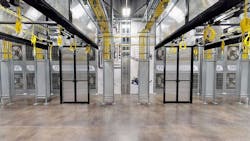Aligned Energy Looks to Innovate in Data Center Supply Chain
Hyperscale computing is changing the way that data centers are built, powered and funded. Aligned Energy is seeking to be on the front lines of this movement, with new investors and a series of projects to add capacity in major data center markets.
With the backing of Macquarie Infrastructure Partners, Aligned sees an opportunity to work with hyperscale tenants in new ways, and innovate in data center sustainability and construction. Phill Lawson-Shanks, Chief Development Officer for Aligned. notes that Macquarie is one of the world’s largest investors in renewable energy
“They have a bunch of assets which use waste-to-energy, as well as carbon capture,” said Lawson-Shanks. “We’re looking at how we can associate one of these plants with a data center build-to-suit.”
The relationship between Aligned and Macquarie is just one example of how large global investors are bringing change to the data center industry. Recent investments by Macquarie and other infrastructure funds like Brookfield Infrastructure and Stonepeak Infrastructure Partners have the potential to speed the industrialization of the data center, streamlining the delivery of capacity to support the growth of cloud computing.
The interest of these large investment firms is a sign that data centers are becoming foundational components of the global economy, and will be the focus of sustained growth well into the future. It also creates a more competitive environment for the data center industry, as a growing number of developers focus on winning super-sized hyperscale deals.
An Industry Reshaped by Hyperscale Growth
The rise of hyperscale computing has been driven by a group of marquee tech brands, including Google, Microsoft, Amazon, Facebook and Apple. These companies’ demand for larger chunks of space has driven innovation in data center construction, prompting wider adoption of lean construction and pre-fabricated components to accelerate delivery schedules.
It has also tested the supply chain and labor pool, which presents challenges in 2019 as the industry seeks to meet the ambitious timetables and budgets for hyperscale customers.
With its focus on “smart infrastructure,” Aligned believes it can address the needs of hyperscale customers. It also sees an opportunity in the growth of “platform companies” like Uber and Lyft that are using software and logistics to disrupt existing industries.
“We’re going after the hyperscale customers,” said Lawson-Shanks, who said Aligned’s new facilities are “designed as a data factory. That’s going to be essential as the hyperscalers and the large platform companies grow. They’re all mimicking the hyperscale companies and (the approaches) they have been using. They want to run their own infrastructure, but operate on the same structure of highly-dense compute, an intelligent network, and a lot of AI (artificial intelligence) to manage.”
Aligned Energy specializes in solving capacity management challenges through innovation in cooling and the supply chain. Last year’s investment by Macquarie brings new capabilities on that front.
“It gives us the ability to plan and strategize with our supply chain,” said Lawson-Shanks. “With Macquarie’s backing, we have the ability pre-purchase energy gear. It enables us to manage our cash flow, and makes us very nimble.
“We’re also looking at different ways of producing the buildings,” he said. “It’s a different mindset.”
Building On-Site With New Materials
Aligned is using fiber-reinforced polymers (FRP) in place of steel in parts of its construction process, Lawson-Shanks said. FRP is a strong composite material that resists corrosion. It has been used in the oil and gas industry, bridge construction and other projects that need the structural strength of steel, but are located in harsh environments. FRP is also used in sound barriers because of its ability to absorb noise.
“It’s just a better way of building things,” said Lawson-Shanks, who said Aligned is using FRP in parts of its new data center project in Ashburn, Virginia. Aligned is currently using a manufacturer and shipping the FRP components to its site. But with Macquarie’s backing, Aligned hopes to shift to on-site production of FRP, which can be created through a process known as pultrusion.
“We’re working on having a flatbed truck that can build the structure on site, which would be quicker and save money on shipping,” said Lawson-Shanks. “We’re trying to stick to the additional sustainability ethos as well.”
In addition to on-site construction, FRP also offers an alternative to steel, which has been impacted by the Trump Administration’s tariffs.
Under the leadership of CEO Andrew Schaap, sustainability has become a more prominent theme in the company’s offerings. Renewable energy is a key priority for hyperscale customers, who are becoming larger players in global energy markets. The opportunity to combine a data center with on-site wind or solar energy infrastructure could be an intriguing option, particularly in markets where green energy is difficult to procure through utility providers.
“Macquarie is very keen to support these environmental goals,” said Lawson-Shanks. “It makes it easy for us to see the world differently and see a better way of doing things. We have the option to do things in new ways.”
Digital Infrastructure Matures and Grows
Macquarie’s interest in the data center sector is part of its growing focus on digital infrastructure. Funds like Macquarie have traditionally invested in projects like airports, utilities and toll roads.
“The definition of infrastructure is changing,” said Lincoln Heilner, a Vice President at Macquarie Infrastructure. “For us, to miss out on that would be missing a tremendous opportunity. Our investors want to participate in this part of the world.”
Heilner spoke about Macquarie’s new focus at an Infrastructure Masons’ forum at the recent DCD Enterprise New York conference. He said infrastructure funds invest third-party capital on a 10-year basis, a slightly longer time frame than the private equity funds that have historically been the most active investors in the data center industry.
A row of cabinets inside a containment system within an Aligned Energy data center. (Image: Aligned Energy)
“We’re really that long-term capital that wants consistent returns over a long period of time,” said Heilner. “We’re not inventing data centers. They are now assets that are a durable part of the value chain.”
By financing new approaches to scale and efficiency, Heilner said, infrastructure funds can add value to an existing industry.
“We’re looking for a sustainable business that will grow very large,” said Heilner. “How do you map that journey forward? How do you industrialize the business and execute that journey? How can you build a machine that does all those things and drives those processes at scale?”
That includes an emphasis on a consistent, repeatable process and ease of delivery. “I think supply chain is really important,” said Heilner. “The installation of the product needs to be industrialized. We were obviously focused on cooling, power and future-proofing when we invested in Aligned.”
The Road Ahead
In a crowded field of competitors pursuing hyperscale deals, Aligned has focused on future-proofing data center infrastructure for the changing needs of next-generation technologies.
Cooling has always been a particular focus for Aligned, which was founded in 2015. The company’s Delta Cube (Delta 3) heat rejection technology allows customers to add power capacity instead of more space, housing up to 50kW per cabinet in IT equipment. Aligned describes its design as an “adaptive data center” which enables tenants to put low-density and high-density racks next to one another in a data hall, a configuration which is often problematic.
“The ability to dynamically scale cooling is radically different,” said Lawson-Shanks. “What we do here makes life so much easier. The opportunity for our customers to expand in place is very interesting to the hyperscale crowd.”
Data center rack density is trending higher, prompted by growing adoption of powerful hardware to support artificial intelligence applications. This will create a growing opportunity for specialists in high-density hosting.
Aligned launched its first data center in Plano, Texas in 2016 and its second site in Phoenix in May 2017. Last year it has announced new campuses in Salt Lake City and Ashburn, Virginia.
The first building in Salt Lake City is already full, and Aligned has begun adding a second phase, with room for future capacity.
In Ashburn. Aligned is building from the ground-up on a historic telecom property in “Data Center Alley.” The first building features a two-story design, consistent with the shift to taller data centers in Northern Virginia, the world’s largest and most competitive data center market. The company is topping off the building this month, and Lawson-Shanks said the first 12 megawatts of capacity will be available in the next 90 days.
Aligned is also actively tracking properties across 60 locations for potential build-to-suit sites and campuses for hyperscale clients.
“We’re constantly looking at land adjacent to where large customers are looking to build,” said Lawson-Shanks. “Should a customer want a site, we can execute very quickly.”
About the Author




